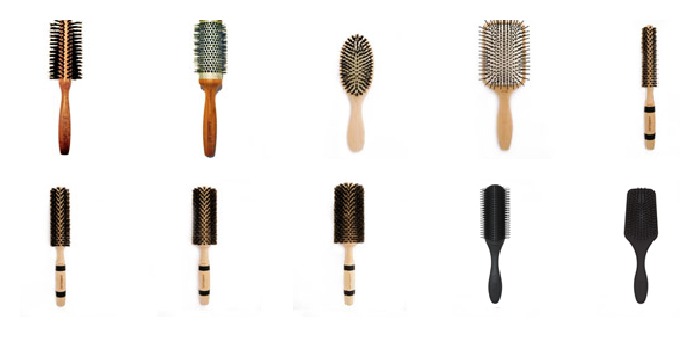Finding the right brush for yourself can prove to be complicated. The kind, size, and bristle all play a part in what your desired end look would be. Here we will explain the difference between them to help you make the right choice for yourself.
Brush Type
Wet brush
The wet brush is actually great for a couple of reasons: not only do its flexible bristles help detangle wet hair without breaking it, but it’s also the perfect brush for ladies with thin hair. Because its bristles are so gentle, it works through knots without snapping fine strands, and its padded cushion moves along your scalp to prevent further breakage.
Vented brush
The brush has widely spaced, flexible bristles. Openings in the head (where the bristles are attached) allow for good airflow. Vented brushes are primarily used for drying hair because they offer superior airflow, making short work of moisture. The ends of the sparsely spaced bristles have tiny, protective balls to guard against hair damage. Vented brushes maintain natural movement because their bristles never force the hair into a specific shape.
Cushioned brush
This category of brushes includes the oval-shaped cushioned brush (padded head where the bristles are attached) for simply brushing out the hair and the flat paddle brush with an air cushion that’s used exclusively for long hair. A great paddle brush can also be an asset for redistributing your natural oils and creating coveted shine. The cushion and bristles are designed to collapse anytime they meet resistance; hence, they prevent long hair from being stretched, split, or broken.
Round brush
Round brushes look exactly as named: They have a round, metal barrel for more defined movement. Use a round brush any time you want the hair to have some bend or curl, but not as much as curling irons or hot rollers would provide. The metal barrel fills with hot air from the blow dryer, while the vented holes create plenty of air circulation. This design enables you to dry the hair in half the time and create a crisper hair shape. The one caution is to keep the blow dryer moving and check your handiwork frequently to avoid over-drying, or possibly damaging the hair.
Large
A larger, round brush is going to make the hair straighter with more of a curve. “If you have wavy or curly hair, large to extra large round brushes are going to decrease the volume and make the hair straighter and smoother
Small
A smaller round brush is going to create more bend in the hair.
Styling brush
Classic styling brushes have a half-rounded head. They traditionally have five, seven, or nine rows of stiff nylon bristles — seven being the most popular. This style is referred to as a half round brush because the head of the brush has a rubberized, slightly rounded shape to create a slight bend in the hair. The classic styling brush is the tool of choice when creating smooth, sleek, precise hairstyles that aren’t stick-straight. A classic style brush can be used with curly hair the bristles are moveable, so they won’t snag your spirals, and it’s good for detangling wet locks. The bristles are wide enough that it actually helps your curls clump together for a more defined wave pattern.
Bristle Type
Boar
This bristle is the actual hair of a boar (hog). Boar bristles are considered ideal because they close the cuticle layer — the outside armor of your hair — and create shiny hair. Boar bristles help keep moisture in the hair. Because boar bristles tend to be weak, manufacturers usually mix them with nylon bristles, so they don’t collapse while you’re brushing through the hair.
Boar bristles are natural, soft, flexible bristles that gently brush the hair and are suitable for use on children.
Nylon
This name represents a catchall category for all types of bristles made of plastic, nylon, rubber, or similar materials. Nylon bristles can be soft and flexible or stiff and firm.
Nylon bristles offer little to maximum control, depending on how closely the bristles are placed and how flexible the material. As a rule, the stiffer and more closely spaced the bristle, the more control you have over the hair.
Porcupine
Porcupine is a term used for a tufted bristle — multiple bristles grouped together — that usually includes a combination of boar and nylon bristles. It’s gentle, but it exerts a good hold on the hair.
This design is excellent for controlling fine hair, as well as for thoroughly brushing thick hair right down to the scalp.
Metal
Unless you’re styling a wig, stay away from this category of bristles. Metal bristles — even with soft plastic tips — are too inflexible to safely use on human hair.
Not recommended for anything but wigs and hairpieces.

Recent Comments